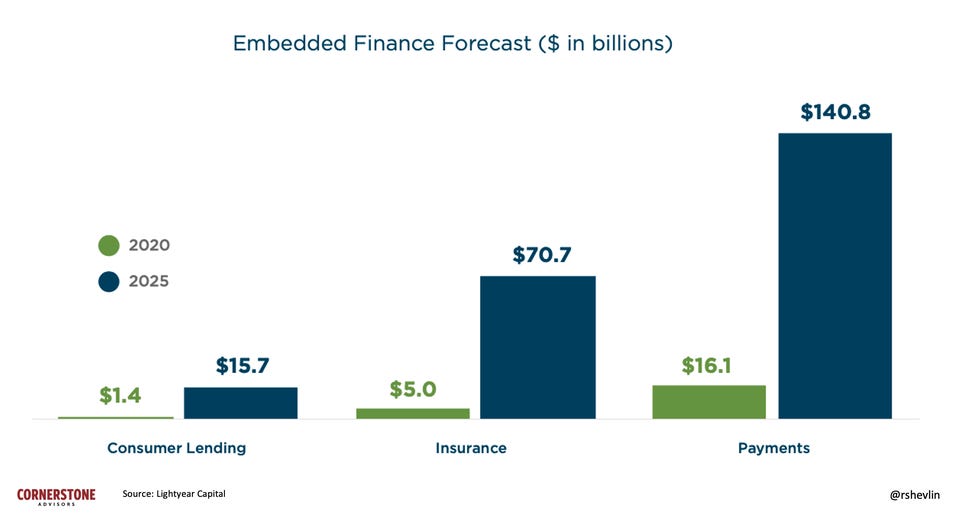
Fintech Trends – What Shapes the Financial Services Market?
The fintech industry is among the most dynamically developing ones. New solutions are being constantly implemented at finance companies in order to increase their efficiency. Find out what fintech trends will affect the future of the financial sector and how.
Fintech revolution continues
The Venture Scanner research summarizing 2021 shows that investments in the fintech industry increased that year by 144% compared to 2020. Companies on the financial market are more and more intensively developing their solutions and implementing modern technologies. This is aimed at increasing both customer satisfaction and the operational efficiency of the company.
The State of Fintech report from the same year shows that payment methods and banking services are currently the most popular in the industry. The development of the fintech industry began with the creation of solutions related to payments and loans, but now fintech startups are also dynamically operating in other financial sectors (on the cryptocurrency market, in banking, insurance, etc.). Fintech organizations are currently responsible for 30% of technology investments around the world.
Designing new payment methods and improving existing ones is the result of intense competition and the development of ecommerce businesses. E-banking and various related solutions are very popular. There are nearly 170 million mobile banking users in the United States alone. It turns out that as many as 27% of respondents around the world use the services of neobanks (online banks), while almost 1 in 10 respondents treat a neobank as their main bank. In response to the popularity of online banks, traditional banks collaborate with fintech companies more and more often to increase the attractiveness of their services and implement solutions based on the latest technologies.
1. Blockchain in mobile banking services
Blockchain technology has completely changed the view of many industries (including fintech) on the future of services. In theory (the lack of legal regulation may pose some risk), it allows carrying out transactions safely and without any intermediaries.
The potential of blockchain isn’t limited to cryptocurrency trading. This technology can be used for securely sharing sensitive data with other users, foreign payments, real-time data transfers to IoT (Internet of Things) devices, system monitoring, etc. One of the most important ideas today is DeFi (Decentralized Finance). It assumes the possibility of transferring any financial service (sale, loan, saving) into a blockchain, thanks to which you can bypass intermediaries (brokers, banks) and save money. Another novelty is ownership tokenization using the NFT (non-fungible token) technology. A token is simply a digital confirmation of the value of a tangible or intangible asset, or a confirmation of ownership of this asset.
Although carrying out transactions using blockchain can prove to be extremely beneficial financially, the technology still has weaknesses. There aren't many legal provisions that would regulate the use of this solution within the economy, hence some companies approach this trend with caution.
2. Virtual reality and augmented reality
So far, there haven't been many cases of using VR technology in the financial sector. It is, however, one of the solutions of the future, and fintech organizations are considering how to use it to make financial services more attractive. Most likely, in the future, users will be able to invest in stocks or trade currencies via virtual reality. There's a high probability that virtual and augmented reality will be the key elements of Metaverse (if it is ever created) – the new virtual reality that the creator of Facebook intends to work on.
Attempts to use VR and AR have been made, for example, by MasterCard – in order to make it easier for its customers to fully explore the advantages of having a specific card in a virtual space. It’s worth noting that for both finance companies and ecommerce, these technologies are extremely important due to the quality of experience they guarantee to potential users. AR and VR can also be useful in ensuring the security of the clients of finance companies. Biometric verification techniques in AR and VR can be used to effectively protect users against fraud and attacks in the digital space.
3. Robo-advisors
The development of machine learning and artificial intelligence allows designing virtual assistants or robo-advisors who are able to provide clients with an experience resembling a conversation with another person. Although no artificial intelligence can yet compete with the intelligence and sensitivity of a living, human customer service specialist, companies have been using virtual advisors for some time to automate and speed up some customer service processes, as well as to provide professional 24/7 customer support.
Robo-advisors can independently manage investments and even propose personalized services and products, based on advanced analysis and recommendation engines. By using big data (unimaginable amounts of diverse data), clients can achieve much better returns on their services and investments.

Wealthfront is an example of a robo-advisor.
Bots can also help solve clients' problems. Chatbots, which with the help of NLP (natural language processing) are able to analyze written questions or speech and support the user almost as effectively as a live advisor, are most often used for the purpose of solving customers’ issues. Chatbots are capable of providing basic answers to clients' questions, but also of making decisions on granting a refund or discount. Thanks to the machine learning used by fintech companies, virtual assistants can learn from conversations with clients and adjust future interactions with them accordingly. Bots process historical data (such as those related to purchases) and real-time inputs (such as messages) to learn and predict future clients' behavior.
4. Process automation
The process automation technology uses software to automate the simple, monotonous tasks usually performed by people. In the financial industry, this allows you to lower the costs and improve the overall organizational performance. Programs get the job done faster and better than humans. They also don't make errors. Finance companies can therefore focus on the essential challenges, leaving the less important ones to the machines.
Many processes can be automated, e.g. monitoring of company systems in terms of dangers, client onboarding, account operations, card payment processing, or initial approval of a mortgage application. Thanks to automation, you can save your employees' time and redirect their energy to more ambitious tasks that require creativity.
5. Voice-enabled payments
Voice assistants have quickly gained popularity. Modern voice support technology allows people to use human speech recognition software and digital assistants such as Siri, Google Assistant, or Alexa. Using a smartphone and voice-controlled services, the user can find out what their balance is, make quick payments or traditional money transfers.
Such a service has two significant advantages. Firstly, it enables fully contactless payments without the use of a terminal. Secondly, it allows for easy funds management for people with eyesight problems. In addition, this method of payment is simply convenient because it doesn't require using a card or operating a smartphone with hands.
6. Regulatory technology solutions
The increase in the number of digital services and products has increased the amount of fraud, hacking attempts, and data safety breaches. Due to the high risk, compliance with regulations is imperative to protect clients' data. This is made possible by special solutions designed for this purpose – they are referred to as RegTech (short for regulatory technology). They will greatly facilitate the management of the regulatory process in the financial industry by using modern technologies. The main functions of RegTech software include reporting, monitoring, and compliance. These programs can also reduce administrative costs, ensure financial stability, and help protect clients.
7. Embedded banking
Embedded banking refers to additional services or products (banking, payment, insurance) offered by companies that haven't been involved in financial activities so far (e.g. Starbucks, Orlen Pay, Uber, and others).
Such companies very often closely cooperate with fintech firms that help them to provide these additional services their clients need (e.g. related to making or sharing payments). The introduction of financial services allows organizations to create a new source of income. Collecting multiple services within a single application or on a single website improves customer experience and increases the client's loyalty to a specific brand.

Fintech trends - summary
Designing new financial solutions is fuelled by the ever-growing client needs and the competition between brands. There are many interesting solutions that you can implement at your finance company to improve your customer experience or gain an additional source of income. A modern financial website will allow you to present the technologies used by your company and build an image of an innovative organization.
The solutions that we can implement on your web page include advanced cybersecurity solutions, integrations with external systems, chat, loyalty programs, financial calculators, and many more. We'll be happy to help you create a website for your financial company.













